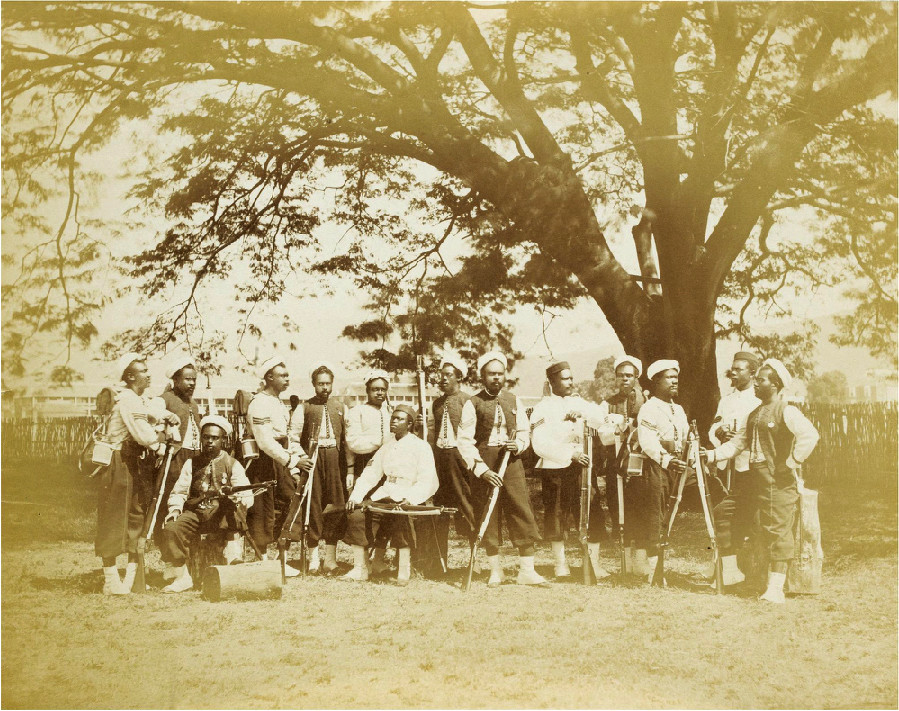The Beinecke Library has acquired the William Walker Whitehall Johnston Photograph Album of Wales, the West Indies, and the 1st West India Regiment (GEN MSS 887). This extraordinary photograph album documents people and the built landscape of the West Indies, circa 1859-1865, including enlisted men, non-commissioned officers, and officers in the 1st West India Regiment. The photographs of the regiment depict soldiers, officers, military exercises, and barracks. A group portrait shows officers involved in the Morant Bay Rebellion, including Johnston and generals Luke Smythe O’Connor and Alexander Abercromby Nelson.
Photographs of sites in the West Indies include buildings, markets, and streets. Many images depict sites in Nassau on New Providence, including Christ Church Cathedral, Fort Charlotte, Fort Fincastle, Market Street Arch, Old Fort of Nassau, Queen’s Staircase, and Vendue House, as well as the residence of the governor and an octoganal-shaped city jail. Images of sites in Kingston, Jamaica, include the Coke Memorial Methodist Church, Kingston Theatre, and Up-Park Camp. Several photographs show the settlement and barracks at Castries, Saint Lucia. Photographs of Port of Spain, Trinidad include views of Marine Square and Almond Walk. Photographs of Havana, Cuba depict the Plaza de Armas, including El Templete, the Palacio de los Capitanes Generales, and a monument to Ferdinand VII of Spain. There are also photographs of the lighthouse at Great Isaac Cay, South Bimini Island. Photographs of sites include several panoramic photographs.
The album also includes photographs documenting a stay by Johnston with the Tennant family at Cadoxton Lodge Estate in Cadoxton-juxta-Neath, Wales. Images include portraits, including portraits of Johnston’s brothers, as well as several members of the Tennant family, such as Charles Tennant and Henry Tennant; views of the Cadoxton Lodge Estate, including the house and garden; and several views of the Neath Abbey ruins. Other images include views of iron and tin works, Aberdulais Falls, the Tennant Canal, and the beach at the Mumbles near Swansea. Several photographs depict sites in London, including workmen and boys gathered at the construction site of the Victoria Railway Bridge (later known as the Grosvenor Bridge) over the River Thames.
A detailed description of the album can be found online: William Walker Whitehall Johnston Photograph Album of Wales, the West Indies, and the 1st West India Regiment (GEN MSS 887).
William Walker Whitehall Johnston (1835-1886)
William Walker Whitehall Johnston was an officer in the British Army. He was born in Trinidad, where his father, Thomas Francis Johnston (circa 1808-1873) served as a Colonial Secretary. In the British Army, Johnston held ranks from ensign to lieutenant-colonel in the 1st West India Regiment. He commanded troops in Jamaica, British Honduras, and West Africa in the Ashanti War, 1873-1874. Johnston married Mary Elizabeth Farrington (circa 1835-circa 1884), circa 1860, and they had two children, Frances Maude Johnston Hilditch (circa 1862-1895) and William Charles Caley Johnston (1870-1918). In 1884, he married Matilda Ricketts (born circa 1856). Johnston died in London in 1886.
West India Regiment
The West India Regiment was an infantry unit of the British Army recruited from and normally stationed in the British colonies of the West Indies between 1795 and 1927. Intially the regiment sought to recruit both free blacks from the West Indian population together with purchased slaves from West Indian plantations. After the abolition of slavery, enlisted men in the regiment were black West Indian volunteers, with white officers and some senior non-commissioned officers from Great Britain.
Charles Tennant (1796-1873)
Charles Tennant was an English politician and landowner. From 1830 to 1831 Tennant was Member of Parliament for St Albans, and supported the Representation of the People Act 1832 (commonly known as the Reform Act 1832). In 1830 he was one of the founders of the National Colonisation Society, advocating emigration to British colonies. His political publications include The People’s Blue Book (1857) and The Bank of England and the Organization of Credit in England (1866). Tennant also owned Cadoxton Lodge Estate in Cadoxton-juxta-Neath, Wales.
(MM)

